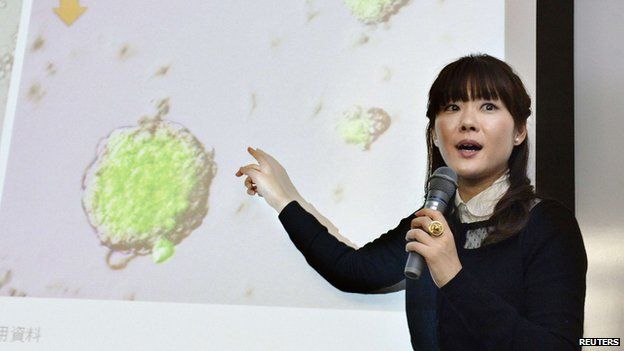Stem cell 'breakthrough data inappropriately handled'
- Published

An investigation into a supposedly groundbreaking stem cell study in Japan has discovered "inappropriate handling" of the data.
It was reported in January that dipping cells in acid could cheaply and quickly convert them into stem cells.
Questions were raised about the images used in the scientific report and other research groups have failed to reproduce the results.
The interim report has not found any evidence of research misconduct.
Stem cells can become any other type of tissue and are already being investigated to heal the damage caused by a heart attack and to restore sight to the blind.
The original study, published in the journal Nature, became a huge story globally and was described as "remarkable" and a "major scientific discovery".
It offered a cheap and ethical source of stem cells that could have helped make them a practical treatment rather than a researcher's dream.
Similar images
But significant doubts have emerged.
One centres on the use of images in the scientific report by the team at the Riken Centre for Developmental Biology.
They were similar to images from previous research by one of the scientists involved, Dr Haruko Obokata, which did not use the acid-bath technique.
Meanwhile, teams around the world have failed to produce stem cells using the reported technique.
A review by Prof Kenneth Ka-Ho Lee, at the Chinese University of Hong Kong, published on ResearchGate, concluded: "The ease and simplicity of their method for generating STAP cells [the name given to stem cells produced by this method] from various stressors and cell types have left the readers in doubt.
"We have tried our very best to generate STAP cells using their protocol and it appears that it is not as simple and reproducible as we expected.
"So whether the techniques really works still remains an open question."
'No malice' intended
Riken launched an investigation and the first findings are now being reported.
It has found that some images had been "inadvertently" left in the report and there was "no malice" intended.
However, a conclusion has not yet been reached on allegations that part of the methodology had been copied from another scientific paper or that images in the paper resemble those from Dr Obokata's previous research.
In a statement, the president of Riken, Prof Ryoji Noyori, said: "I would like, first and foremost, to express my deepest regrets that articles published in Nature by Riken scientists are bringing into question the credibility of the scientific community.
"It is extremely regrettable that significant discrepancies have been found to have been generated in the process of preparing the Nature articles for publication.
"We are investigating these discrepancies, with the understanding that it may become necessary to demand the withdrawal of the articles."
This week, a member of the research group called for the findings to be withdrawn as it was no longer clear what was right.
Prof Teruhiko Wakayama, of the University of Yamanashi, told Japanese TV: "When conducting the experiment, I believed it was absolutely right.
"But now that many mistakes have emerged, I think it is best to withdraw the research paper once and, using correct data and correct pictures, to prove once again the paper is right.
"If it turns out to be wrong, we would need to make it clear why a thing like this happened."
- Published10 March 2014
- Published29 January 2014